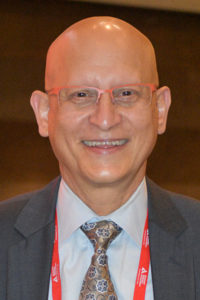
A panel of exercise scientists discussed health disparities and sex differences in physical activity during a morning symposium on Saturday, June 4. The session, Reaching Everyone—Health Disparities and Sex Differences in Physical Activity, was livestreamed and can be viewed on-demand by registered meeting attendees at ADA2022.org. If you haven’t registered for the 82nd Scientific Sessions, register today to access the valuable meeting content.
Disparities in physical activity affect all segments of the population and are impacted by factors such as state of residence, type of neighborhood, education level, income level, and occupation level. Even marital status makes a difference, but in men only, according to Carlos Crespo, PhD, Vice Provost for Undergraduate Training in Biomedical Research at Portland State University.
Dr. Crespo referenced a U.S. map highlighting what he called a “preponderance of physical inactivity” in warm Southern regions, including Kentucky, West Virginia, and even Puerto Rico. Yet balmy Hawaii and brutally cold Minneapolis show high levels of activity.
“We also have an urban-rural divide in physical inactivity,” said Dr. Crespo, who reviewed a small study that he and his students conducted that involved placing a sign near an escalator urging people to use the stairs. The number of White and Hispanic people using the stairs increased but the number of Black people using the stairs decreased. When the sign was changed to include a photo of a Black woman, the number of Black people using the stairs significantly increased.

“And the moral of this story is, talk to people in the language that they want to hear, where they actually feel themselves as part of the message,” Dr. Crespo said.
Natalie Colabianchi, PhD, Professor and Program Chair of Applied Exercise Science and Director of the Environment and Policy Lab at the University of Michigan School of Kinesiology, discussed the links between neighborhood walkability and physical activity, obesity, and incidence of diabetes. Neighborhood walkability includes factors such as land-use mix, population density, street connectivity, and even aesthetics.
The REasons for Geographic and Racial Differences in Stroke study found that people living in low-walkability areas experienced a 20% decrease in moderate to vigorous physical activity. The study also found that living in a very walkable neighborhood was associated with a 25% to 45% decreased risk of being obese or overweight relative to living in a car-dependent neighborhood.
There aren’t any published studies linking walkability to diabetes, so Dr. Colabianchi ran her own analysis, looking at data from 7,000 participants in other walkability studies. She found that living in somewhat a walkable neighborhood was associated with a decreased risk and incidence of diabetes.
Siana Jones, PhD, Research Fellow in Population Science and Experimental Medicine at the Institute of Cardiovascular Science at University College, London, discussed the impact of biological sex and ethnicity on physical activity.

Physiology arises from complex interactions between our biology and the environment, Dr. Jones said. One important physiological factor that can impact physical activity and training is cardiorespiratory fitness, which determines a person’s capacity to perform dynamic, moderate-intensity exercise over a prolonged period. It’s usually quantified by measuring Vo2 max, which is the maximum amount of oxygen an individual can deliver and utilize to produce energy for economic exercise.
Dr. Jones said that women, who have smaller lungs and hearts than men, also have a lower Vo2 max than men. Studies also show that Vo2 max is lower in Black and South Asian people than in Mexicans and White Americans.
Dr. Jones also cited a study showing that Black Americans have a higher proportion of type 2 myofibers versus type 1 myofibers compared to White Americans. Type 2 myofibers have reduced oxidative capacity, while type 1 myofibers have a higher oxygen capacity, higher myoglobin, higher capillary density, and higher mitochondrial content.
A high proportion of type 2 muscle fibers is directly associated with obesity, hypertension, and diabetes, she said. Type 2 fibers also increase fatigue and reduce endurance, leading to a reduction in physical activity and potential weight gain.
“However, it’s really important here to recognize that type 2 myofibers do have the capacity to improve their oxidative capacity in response to aerobic training,” said Dr. Jones, who reviewed a handful of other studies that compared physiological differences in men and women, and amongst different ethnicities.

“It’s extremely important for future work that we understand and address the impact of factors such as our living environment, our lifestyle, and socioeconomic disadvantage and how they impact physiology, physical activity, and training levels,” she said. “The key point here is that understanding the impact of diversity and sex on participation and response to physical activity will permit us to hopefully design more specific and effective interventions that could mitigate these health inequalities.”
Jane E. Yardley, PhD, Associate Professor of Social Sciences at the University of Alberta, Canada, concluded the session with a review of factors that affect physical activity in women with type 1 diabetes.
Type 1 diabetes patients who exercise regularly and are physically active live five to 10 years longer and have a lower risk of heart disease than sedentary people with type 1 diabetes, she said. They also develop fewer diabetes-related complications. Active people also maintain a healthier body weight and maintain better lean body mass and bone density as they age.
“The problem is that when you put type 1 diabetes in here, it can actually be dangerous to exercise unless you’re doing it in a very precise way. And to do that, you need to have all the right information,” Dr. Yardley said.
Women with type 1 diabetes have an additional barrier to exercise: fear of hypoglycemia. Planning and time-management go hand-in-hand with physical activity to manage glucose during and after exercise, and then again before going to bed.
“It takes a lot of effort to be able to do it safely, to make sure we’re on the same page, vocabulary-wise, for some of the types of activities that we’re talking about,” Dr. Yardley said. “And, also, to look at where the fuels are stored and coming from, because these are very important in understanding the risk of hypoglycemia.”
[sub-post-content]